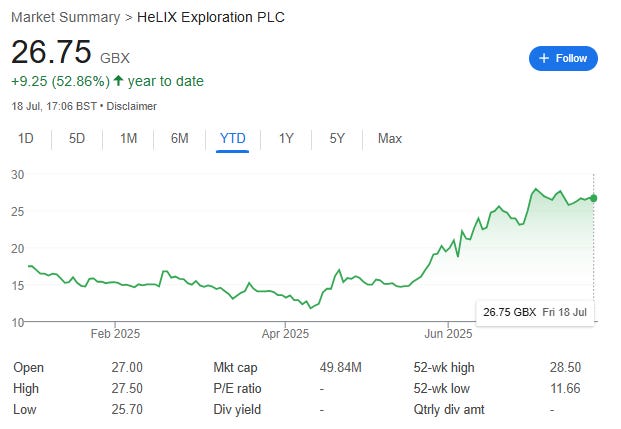Helix Exploration
Still Going Strong
Good Afternoon Team.
I’m here to interrupt your Sunday afternoon to briefly chat Helix.
Three months ago, I took a stab at the numbers, just as the stock was beginning its recovery from the — depending on your outlook — 12p confidence crisis/awesome opportunity.
Happily, that recovery has continued — and we’re now up more than 50% year-to-date.
I want to make a broader point here: even with cheap IPO shares, the stock was structured and valued fairly at launch. That foundation has helped drive the rise since.
There’s a lesson in that for others.
Back in April, I outlined the investment case: five wells generating $20 million in revenue annually, and applying a conservative 4x early-stage multiple, would imply an $80 million market cap.
We’re now nearly there.
There’s more to come.
Let’s dig in
Minchin is now describing HEX’s journey as one ‘towards becoming a leading helium producer in North America.’
That’s a bold claim.
But realistically, if Rudyard performs as expected, this won’t be an independent for long. One of the major players in the North American helium cartel will come knocking within the next 18 months.
The Drachs family office — with over $1 billion in AUM — joined the £4.5 million placing in June as cornerstone investors. I don’t know them personally, but people I trust do. They’re not in this for modest gains. They’re here for the endgame.
Also worth noting is the OTCQB listing. Like all OTC listings, volume starts slow — sometimes non-existent — and then suddenly rockets.
It took a while with GMET.
But if you're competent enough to already have one when US interest kicks in (Bitcoin treasury companies, take note), you’re way ahead of the curve.
It’s cheap to maintain and invaluable when a stateside fund wants in — and you want to make that easy.
Engine, Engine #5
Last Monday, HEX announced that Inez #1 had completed drilling to 6,510 feet at Rudyard — showing helium concentrations of up to 948ppm (that’s 190x background) in drilling mud.
Inez sits around two miles south of Linda #1, which tested 1.2% helium at a flow rate of 3,800 Mcf/d. Both wells are part of the Rudyard Field anticline — a large geological structure confirmed by seismic and shallow historical drilling.
The new results support the continuation of helium-bearing intervals across the broader field.
That’s very good news for wells #6 through #20.
A successful test at Inez could lead to an expansion of proven reserves into the southern dome, de-risking the broader field and materially increasing the company’s commercial resource base.
Next up? Wireline logging, flow testing, and onto the next well.
Production is coming
It's great to see things progressing more or less as expected. Civil works and plant construction began last week, including ground clearance and compaction for a reinforced concrete pad at the highest point on the 20-acre lease.
Bo enthused:
‘With four production wells drilled, a fifth in progress, and equipment mobilisation underway, Helix remains focused on delivering one of the most cost-effective and rapid developments in the North American helium sector.’
Key milestones:
The PSA plant and membrane modules (from Texas to Montana) are on track for August 2025 delivery
The compressor units expected shortly after
The gas gathering system procurement is underway - site installation will begin once the 4” piping arrives from Wyoming
First helium production remains targeted following delivery, integration, and inspection of the remaining components.
From the recent RNS:
‘Final integration and commissioning of the plant remain contingent on delivery of the helium compressor skid. Coordination with vendors is ongoing to finalise control logic, with a preference for a soft-start configuration to reduce fuel usage and improve control during startup.’
For context, the Xebec PSA processing plant (50,000 Mcf/year capacity) was secured for just $500,000. A membrane unit from Germany is also en route, complementing this plant.
Together, they offer a low-cost, scalable path to monetisation and cash flow.
That said, the slightly softer tone in language suggests it’s possible that first ‘real’ production is now more likely to be in Q4 than Q3.
That’s perfectly fine — it just means a steady rise, rather than a sharp one.
Of course, it may well end up happening by mid-September (by the end of US summer, as promised). But it’s infinitely preferable to take the time you need to get it done properly, the first time.
Measure twice, cut once.
Helium & the US
A year ago, oil, gas, and mining were considered ESG pariahs — too dirty even for fund managers specialising in moral ambiguity.
Now? This sector sits at the heart of Sino-US strategic tension.
Investing in domestic extraction and processing is practically an act of national service, and the big players are waking up to it.
The US government directly backing MP Materials — arguably a weak deposit comprised of mostly light rare earths (the low value ones, which funnily enough, for now, need to be shipped to China to process) — tells you how serious things have become.
Ignore the whiners complaining about the price floor destroying the level playing field.
Where were they when China took control of the world’s resources?
Where were they when China built enough processing to near monopolise the market?
If the majors chose not to invest then, they can’t complain now. Exploration budgets still remain at multi-decade lows. You also can’t complain when the US starts paying for this as well.
More state investment is both needed and inevitable given China’s stance and longstanding policy of supporting their own industries - so plan your investments accordingly.
Remember - Helium was already the ‘disappearing element.’ And demand in healthcare, semiconductors, AI, and aerospace is accelerating that trend.
Supply constraints are real. And so is the need for greater US self-sufficiency.
Helix, being a domestic operator, is insulated from geopolitical and trade risks that threaten international peers.
And arguably, this advantage is underappreciated.
The Bottom Line
HEX has told us that it’s ‘in commercial discussions around offtake opportunities, supporting our goal of delivering domestically produced helium directly to U.S. end users and mid-tier distributors.’
There’s a decent chance the next RNS will bear the fruits of these discussions — potentially with a prepayment.
To recap the investment case:
2025: Five wells producing circa $4 million each in annual revenue → $20 million total
Apply a 4x early-stage, risk-adjusted multiple → $80 million market cap (£64 million)
Looking further ahead:
2027: $80 million revenue from 20 wells, with a mature 6x multiple = $480 million market cap
Of course, that assumes everything goes smoothly — and that the company is still listed.
But let’s be honest: it won’t get that far.
The majors will make their offer before it ever does.
Still going strong.





